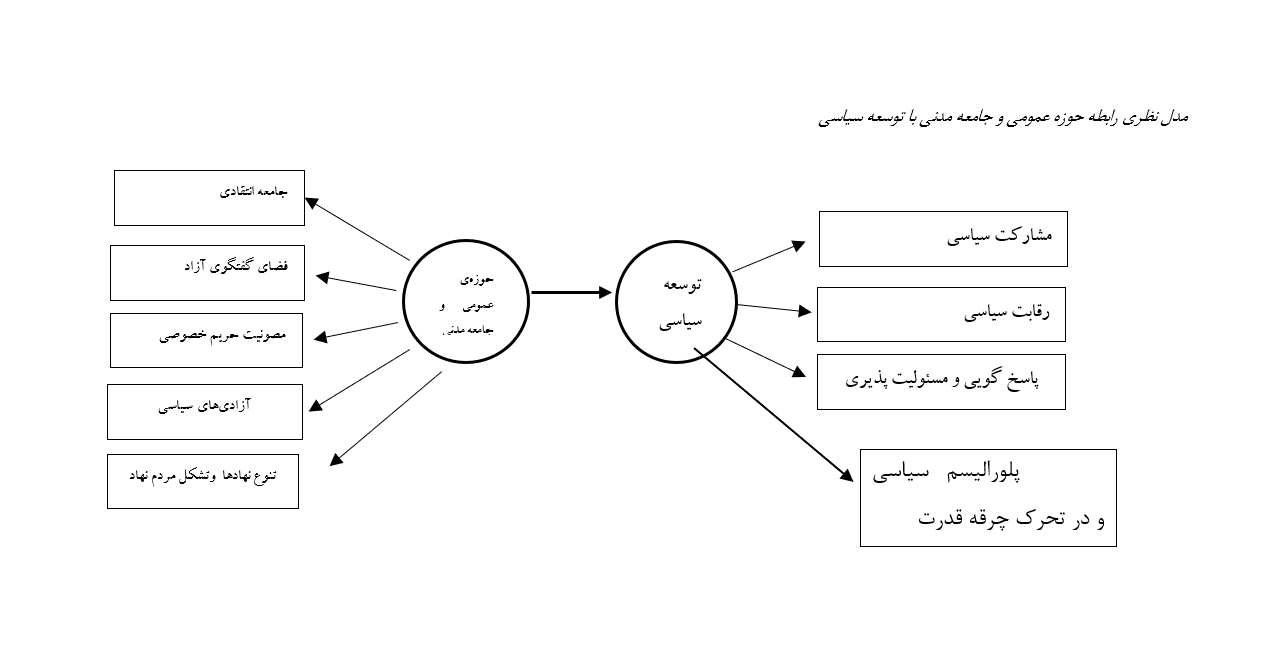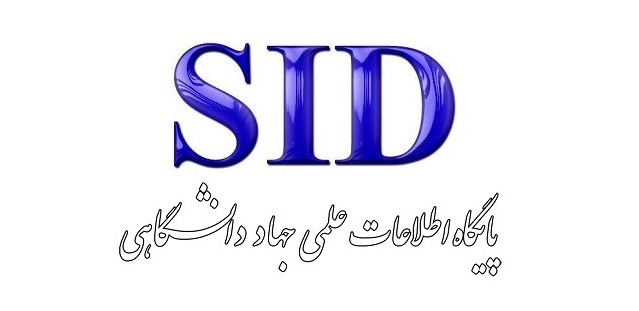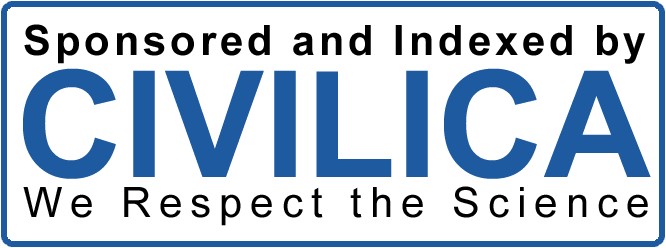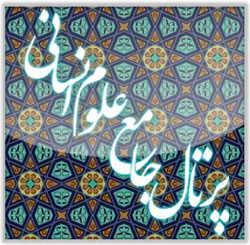Examining the Role of the Public Sphere and Civil Society in the Political Development of Contemporary Iran
Keywords:
Public Sphere, Civil Society, Political Development, Political Parties, Voluntary AssociationsAbstract
Concepts such as the public sphere, civil society, and political development are among the significant topics that have attracted the attention of scholars and researchers in the field of social sciences in recent decades. The public sphere serves as a space for the free and equal participation of all citizens in dialogue within a democratic society, closely overlapping with civil society. When strengthened and integrated, the public sphere can provide the practical framework for the organized activities of political institutions, political parties, and voluntary associations independent of the state. Within an open and critical society with an emancipatory nature, it can facilitate the realization of political freedoms and the fundamental rights of citizens. The formation and evolution of the public sphere and civil society in different historical periods, and their role in the political development of contemporary Iran, have been marked by significant fluctuations. A pivotal moment in their emergence and organization in the country's modern history was during the Constitutional Revolution. However, throughout the tumultuous reigns of the first and second Pahlavi dynasties, despite the relative increase in literacy, the emergence of new middle classes, and the rise of political groupings with diverse ideological orientations, the dominance of a unilateral political structure—prioritizing Western modernity and economic and social modernization—impeded their success. The ensuing struggles and confrontations culminated in the Islamic Revolution of 1979. Ultimately, despite the emergence of diverse networks of political and social groups in the decades following the revolution, civil society in Iran has yet to develop into a dynamic and influential social force. This article aims to determine the levels of relationship between the public sphere and civil society in relation to political development. The present study employs a descriptive-analytical approach, utilizing documentary and library-based data collection methods. The research background and theoretical foundations indicate a close interrelation between the public sphere, civil society, and political development. In other words, the findings suggest that factors such as the presence of an open political environment, a critical society engaged in free dialogue, independent institutions separate from the state, voluntary associations, and the protection of private spheres—by attributing meaning to the fundamental rights of citizens—impact political development. Practical engagement with these indicators can pave the way for the advancement of political development in Iran.
Downloads
References
Afrough, E. (1999). Civil Society and Its Position in Iran. Public Culture Quarterly(18-19).
Aghamohammadi, B., Sedigh, M. E., & Shirzadi, R. (2022). The Function of Political-Civil Institutions and Their Role in the Political Development of the Country. Human Geography Research, 54(4), 1247-1261.
Ahmadi, H. (1998). Collected Articles on Civil Society and Today's Iran. Tehran, Naghshe o Negar.
Akhavan Kazemi, M. (1998). Political Development and Civil Society. Political-Economic Information Journal(127 & 128).
Akhavan Kazemi, M., & Seyed Shams, a.-D. (2018). Research Trends in Political Development in Contemporary Iran. Parliament and Strategy(95).
Amin, S. H. (1997). The Status of Civil Society in the Constitution. Tehran.
Ansari, M. (2004). The Public Sphere as a Discursive Democracy. Specialized Quarterly of Political Sciences, Islamic Azad University, Karaj(1).
Arendt, H. (1973). The Origins of Totalitarianism. New York: Harcourt Brace & Company.
Ataei Valeh, H., Sedigh, M. E., & Amini, A. (2022). The Role of Civil Institutions and Urban Diplomacy in Iran's Political Development. Iranian Political Sociology Monthly, 5(6), 536-558.
Azarshab, M. T., & Asoudeh, R. (2019). The Role of Civil Society in Political Development (Vol. 3).
Bashiriyeh, H. (1999). Civil Society and Political Development in Iran. Tehran, Institute for Modern Science Publishing.
Bashiriyeh, H. (2001). Political Sociology. Tehran, Ney Publishing.
Calhoun, C. (2010). The History of the Concept of Civil Society and the Public Sphere. Legal Research Journal(51).
Chalabi, M. (1996). Sociology of Order. Ney Publishing, First Edition.
Delavari, A. (2015). The Classical Model of Political Development with a Look at the Western European Experience. Planning and Social Development Quarterly(22).
Fakhraei, S. (2009). Jeffrey Alexander's Sociological Thoughts. Sociological studies, 1(4).
Freese, I. (1995). Gesellschaft versus Politik: Anmerkungen zu Hannah Arendts der Philosophie der Politik. Zivile Gesellschaft und Zivilisatorischer Prozess oder Dialektik, 3. (Enzyklopädische Zeitschrift für Philosophie und Wissenschaften)
Ghasemi, Y. (2010). The Relationship Between State and Civil Society in Iran from a Historical Sociology Perspective. Social Sciences Journal(2).
Haji Aghaei, R., & Paknia, M. (2018). Explaining the Position of the Public Sphere and the Political in Hannah Arendt's Political Thought. Journal of Political and International Approaches.
Handal, P., & Habermas, J. (2002). Public Domination. Tehran, Arghanoon Publishing, Issue 20.
Hariri Akbari, M. (2006). Democracy and Civil Society. Journal of Social Sciences, Ferdowsi University of Mashhad, 3.
Held, D. (1999). Models of Democracy. Tehran, Roshangaran and Women's Studies Publishing.
Jalaeipour, H., & Mohammadi, J. (2017). Contemporary Sociological Theories. Tehran, Ney Publishing.
Kamali, M., & Pouladi, K. (2002). Civil Society, State, and Modernization in Contemporary Iran. Tehran, Baz Publishing.
Mousaei, M. (2009). The Relationship Between Social and Economic Development. Institute for Humanities and Cultural Studies, Rahbord(20).
Mousavi, S. G., & Mousavi, H. (2015). Civil Society and Social Development in Iran. Afaq-e Oloum-e Ensani Monthly(36).
Pusey, M. (1987). Jurgen Habermas. London: Tavistock.
Reiss, H. (1971). Kant's Political Writing. Cambridge University Press.
Sabzaei, M. T. (2015). Sociological Analysis of the Public Sphere in Post-Revolutionary Iran. Social Sciences Quarterly(71).
Sariolghalam, M. (2001). Rationality and the Future of Iran's Development. Tehran, Middle East Scientific Research and Strategic Studies Center.
Schumpeter, J. (1996). Capitalism, Socialism, and Democracy. Tehran, Nashr Markaz.
Shiyari, A., & Farhangi, M. M. (2019). The Impact of Government Policies on Political Development and the Formation of Civil Society in Iran. Epistemological Studies in the Islamic University, 23(4), 723-744.
Vafaei, K. (2014). Political Development and Modern Politics. Specialized Quarterly of Political Sciences.
Whitehead, L. (2004). The Uncivil Interstices between Civil and Political Society. In Peter Bunell & Peter Cavert (Eds.), Civil Society in Democratization.

Downloads
Published
Submitted
Revised
Accepted
Issue
Section
License
Copyright (c) 2025 Seyyed Qasem Mousavi (Author); Manochehr Pahlavan (Corresponding Author); Ali Rahmani Firouzjah (Author)

This work is licensed under a Creative Commons Attribution-NonCommercial 4.0 International License.







